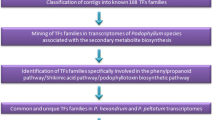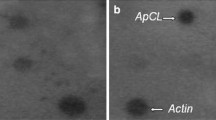Abstract
Podophyllotoxin, an aryltetralin lignan, is the source of important anticancer drugs etoposide, teniposide, and etopophos. Roots/rhizome of Podophyllum hexandrum form one of the most important sources of podophyllotoxin. In order to understand genes involved in podophyllotoxin biosynthesis, two suppression subtractive hybridization libraries were synthesized, one each from root/rhizome and leaves using high and low podophyllotoxin-producing plants of P. hexandrum. Sequencing of clones identified a total of 1,141 Expressed Sequence Tags (ESTs) resulting in 354 unique ESTs. Several unique ESTs showed sequence similarity to the genes involved in metabolism, stress/defense responses, and signalling pathways. A few ESTs also showed high sequence similarity with genes which were shown to be involved in podophyllotoxin biosynthesis in other plant species such as pinoresinol/lariciresinol reductase. A full length coding sequence of pinoresinol/lariciresinol reductase (PLR) has been cloned from P. hexandrum which was found to encode protein with 311 amino acids and show sequence similarity with PLR from Forsythia intermedia and Linum spp. Spatial and stress-inducible expression pattern of PhPLR and other known genes of podophyllotoxin biosynthesis, secoisolariciresinol dehydrogenase (PhSDH), and dirigent protein oxidase (PhDPO) have been studied. All the three genes showed wounding and methyl jasmonate-inducible expression pattern. The present work would form a basis for further studies to understand genomics of podophyllotoxin biosynthesis in P. hexandrum.






Similar content being viewed by others
References
Altschul SF, Madden TL, Schaffer AA, Zhang J, Miller W, Lipman DJ (1997) Gapped BLAST and PSI-BLAST: a new generation of protein database search program. Nucleic Acids Res 25:3389–3402
Anisimova M, Gascuel O (2006) Approximate likelihood ratio test for branches: a fast, accurate and powerful alternative. Syst Biol 55:539–552
Bendtsen JD, Nielsen H, von Heijne G, Brunak S (2004) Improved prediction of signal peptides: SignalP 3.0. J Mol Biol 340:783–795
Broomhead AJ, Rahman MA, Dewick PM, Jackson DE, Lucas JA (1991) Matairesinol as precursor of Podophyllum lignans. Phytochem 30:1489–1492
Canel C, Moraesb RM, Dayana FE, Ferreirab D (2000) Podophyllotoxin. Phytochem 54:115–120
Choudhary DK, Kaul BL, Khan S (1998) Cultivation and conservation of Podophyllum hexandrum—an overview. J Med Aromat Plant Sci 20:1071–1073
Conesa A, Götz S (2008) Blast2GO: a comprehensive suite for functional analysis in plant genomics. Int J Plant Genom 2008:1–13
Conesa A, Götz S, Garcia-Gomez JM, Terol T, Talon M, Robles M (2005) Blast2GO: a universal tool for annotation, visualization and analysis in functional genomics research. Bioinformatics 21:3674–3676
Davin LB, Wang HB, Crowell AL, Bedgar BL, Martin DM, Sarkanen S, Lewis NG (1997) Stereoselective bimolecular phenoxy radical coupling by an auxiliary (dirigent) protein without an active center. Science 275:362–366
Dereeper A, Guignon V, Blanc G, Audic S, Buffet S, Chevenet F, Dufayard JF, Guindon S, Lefort V, Lescot M, Claverie JM, Gascuel O (2008) Phylogeny.fr: robust phylogenetic analysis for the non-specialist. Nucleic Acids Res 36(Web Server issue):465–469
Dereeper A, Audic S, Claverie JM, Blanc G (2010) BLAST-EXPLORER helps you building datasets for phylogenetic analysis. BMC Evol Biol 10:8
Dinkova-Kostova AT, Gang DR, Davin LB, Bedgar DL, Chu A, Lewis NG (1996) (+)-Pinoresinol/(+)-lariciresinol reductase from Forsythia intermedia protein purification, cDNA cloning, heterologous expression and comparison to isoflavone reductase. J Biol Chem 271:29473–29482
Farkya S, Bisaria VS, Srivastava AK (2004) Biotechnological aspects of the production of the anticancer drug podophyllotoxin. Appl Microbiol Biotechnol 65:504–519
Figgitt DP, Denever SP, Dewick PM, Jackson DE, Willians P (1989) Topoisomerase II: a potential target for novel antifungal agents. Biochem Biophys Res Commun 160:257–262
Fukuda Y, Osawa T, Namiki M, Ozaki T (1985) Studies on antioxidative substances in sesame seed. Agric Biol Chem 49:301–306
Gang DR, Kasahara H, Xia ZQ, Vander Mijnsbrugge K, Bauw G, Boerjan W, Van Montagu M, Davin LB, Lewis NG (1999) Evolution of plant defense mechanisms. Relationships of phenylcoumaran benzylic ether reductases to pinoresinol-lariciresinol and isoflavone reductases. J Biol Chem 274:7516–7527
Goswami R, Punja ZK (2008) Molecular and biochemical characterization of defense responses in ginseng (Panax quinquefolius) roots challenged with Fusarium equiseti. Physiol Mol Plant Pathol 72:10–20
Götz S et al (2008) High-throughput functional annotation and data mining with the Blast2GO suite. Nucleic Acids Res 36:3420–3435
Götz S et al (2011) B2G-FAR, a species centered GO annotation repository. Bioinformatics 27:919–924
Huang X, Madan A (1999) CAP3: a DNA sequence assembly program. Genome Res 9:868–877
Iqbal MJ, Yaegashi S, Ahsan R, Shopinski KL, Lightfoot DA (2005) Root response to Fusarium solani f. sp. glycines: temporal accumulation of transcripts in partially resistant and susceptible soybean. Theor Appl Genet 110:1429–1438
Jackson DE, Dewick PM (1984) Aryltetralin lignans from Podophyllum hexandrum and Podophyllum peltatum. Phytochem 23:1147–1152
Jaggi M, Kumar S, Sinha AK (2011) Overexpression of an apoplastic peroxidase gene CrPrx in transgenic hairy root lines of Catharanthus roseus. Appl Microbiol Biotechnol 90:1005–1016
Jantasuriyarat C, Gowda M, Haller K, Hatfield J, Lu G, Stahlberg E, Zhou B, Li H, Kim H, Yu Y, Dean RA, Wing RA, Soderlund C, Wang GL (2005) Large-scale identification of expressed sequence tags involved in rice and rice blast fungus interaction. Plant Physiol 138:105–115
Katayama T, Davin LB, Chu A, Lewis NG (1993) Novel benzylic ether reductions in lignan biogenesis in Forsythia intermedia. Phytochem 33:581–591
Kumar S, Dutta A, Sinha AK, Sen J (2007) Cloning, characterization and localization of a novel basic peroxidase gene from Catharanthus roseus. FEBS J 274:1290–1303
Lata C, Sahu PP, Prasad M (2010) Comparative transcriptome analysis of differentially expressed genes in foxtail millet (Setaria italica L.) during dehydration stress. Biochem Biophys Res Commun 393:720–727
Molog GA, Empt U, Petersen M, Van Uden W, Pras N, Alfermann AW (2001) Deoxypodophyllotoxin 6-hydroxylase, a cytochrome P450 monooxygenase from cell cultures of Linum flavum involved in the biosynthesis of cytotoxic lignans. Planta 214:288–294
Moraes RM, Bedir E, Barrett H, Burandt C Jr, Canel C, Khan IA (2002) Evaluation of Podophyllum peltatum accessions for podophyllotoxin production. Planta Med 68:341–344
Oliva A, Moraes RM, Watson SB, Duke SO, Dayan FE (2002) Aryltetralin lignans inhibit plant growth by affecting the formation of mitotic microtubular organizing centers. Pest Biochem Physiol 72:45–54
Peebles CA, Hughes EH, Shanks JV, San KY (2009) Transcriptional response of the terpenoid indole alkaloid pathway to the overexpression of ORCA3 along with jasmonic acid elicitation of Catharanthus roseus hairy roots over time. Metab Eng 11:76–86
Puranik S, Jha S, Srivastava PS, Sreenivasulu N, Prasad M (2011) Comparative transcriptome analysis of contrasting foxtail millet cultivars in response to short-term salinity stress. J Plant Physiol 168:280–287
Rahman MA, Dewick PM, Jackson DE, Lucas JA (1990) Biosynthesis of lignans in Forsythia intermedia. Phytochem 29:1841–1846
Raina SK, Wankhede DP, Jaggi M, Singh P, Jalmi SK, Raghiram B, Sheikh AH, Sinha AK (2012) CrMPK3, a mitogen activated protein kinase from Catharanthus roseus and its possible role in stress induced biosynthesis of monoterpenoid indole alkaloids. BMC Plant Biol 12:134
Schmitt J, Petersen M (2002) Influence of methyl jasmonate and coniferyl alcohol on pinoresinol and matairesinol accumulation in a Forsythia intermedia suspension culture. Plant Cell Rep 20:885–889
Schroder HC, Merz H, Steffen R, Muller WEG, Sarin PS, Trumm S, Schulz J, Eich E (1990) Differential in vitro anti-HIV activity of natural lignans. Z Naturforsch C 45:1215–1221
Sinha AK, Jaggi M, Raghuram B, Tuteja N (2011) Mitogen-activated protein kinase signaling in plants under abiotic stress. Plant Signal Behav 6:196–203
van der Fits L, Memelink J (2000) ORCA3, a jasmonate-responsive transcriptional regulator of plant primary and secondary metabolism. Science 289:295–297
Van Uden W, Pras N, Visser JF, Malingré TM (1989) Detection and identification of podophyllotoxin produced by cell cultures derived from Podophyllum hexandrum Royle. Plant Cell Rep 8:165–168
Xia ZQ, Costa MA, Proctor J, Davin LB, Lewis NG (2000) Dirigent mediated podophyllotoxin biosynthesis in Linum flavum and Podophyllum peltatum. Phytochem 55:537–549
Xia ZQ, Costa MA, Pelissier HC, Davin LB, Lewis NG (2001) Secoisolariciresinol dehydrogenase purification, cloning, and functional expression. Implications for human health protection. J Biol Chem 276:12614–12623
Acknowledgments
DPW thanks University Grant Commission, India for fellowships. This work is supported by funding by Department of Biotechnology, India.
Conflicts of interest
The authors declare that they have no conflict of interest.
Author information
Authors and Affiliations
Corresponding author
Additional information
Handling Editor: Klaus Harter
Electronic supplementary material
Below is the link to the electronic supplementary material.
Supplementary Fig. 1
Heterologous expression of GST fused PhPLR. GST-PhPLR was induced in E. coli BL21 cell with IPTG (TIFF 2931 kb)
Rights and permissions
About this article
Cite this article
Wankhede, D.P., Biswas, D.K., Rajkumar, S. et al. Expressed sequence tags and molecular cloning and characterization of gene encoding pinoresinol/lariciresinol reductase from Podophyllum hexandrum . Protoplasma 250, 1239–1249 (2013). https://doi.org/10.1007/s00709-013-0505-z
Received:
Accepted:
Published:
Issue Date:
DOI: https://doi.org/10.1007/s00709-013-0505-z




